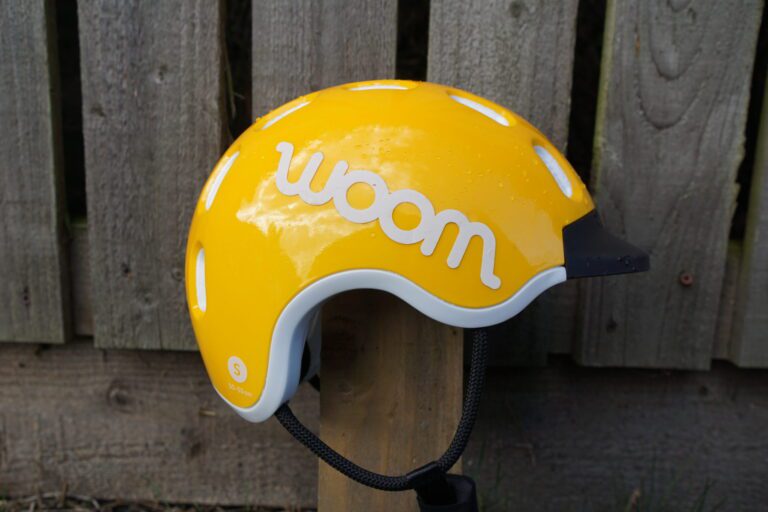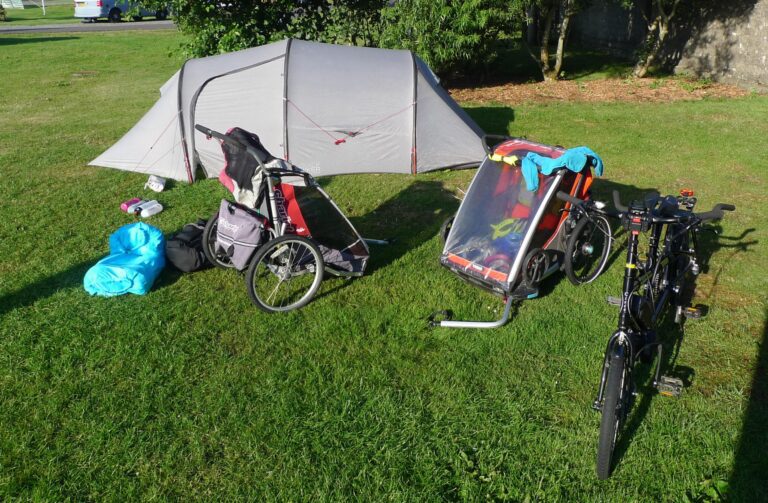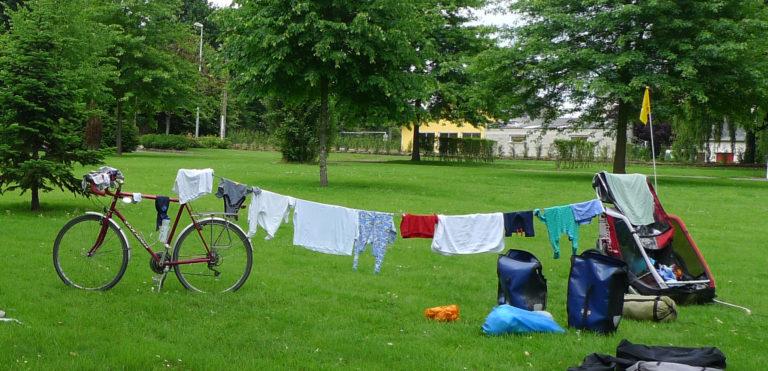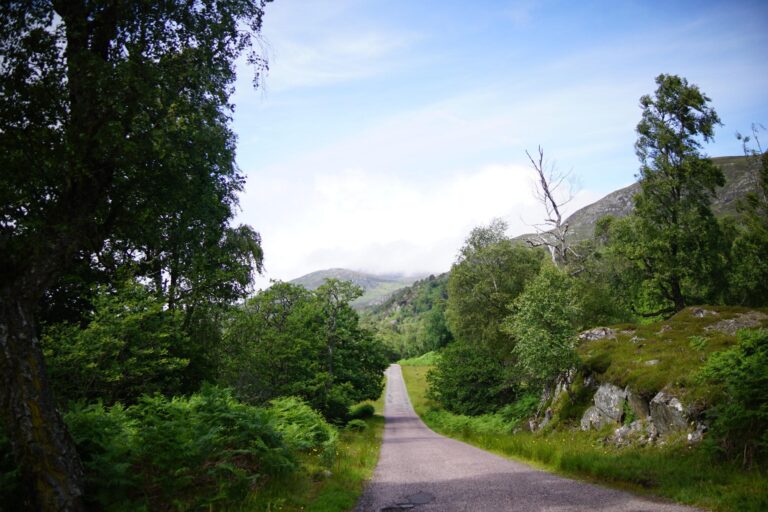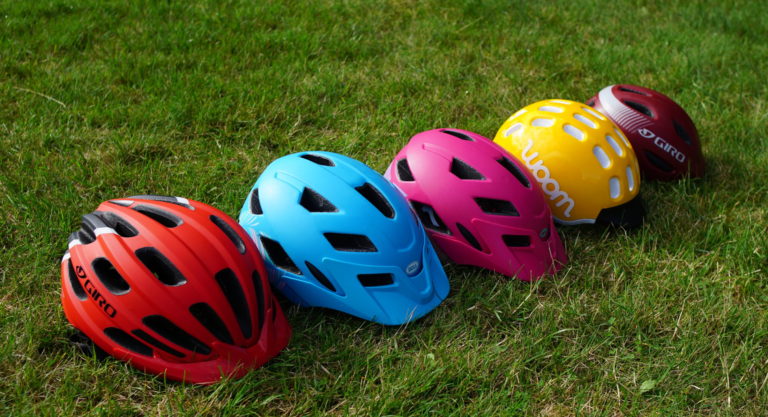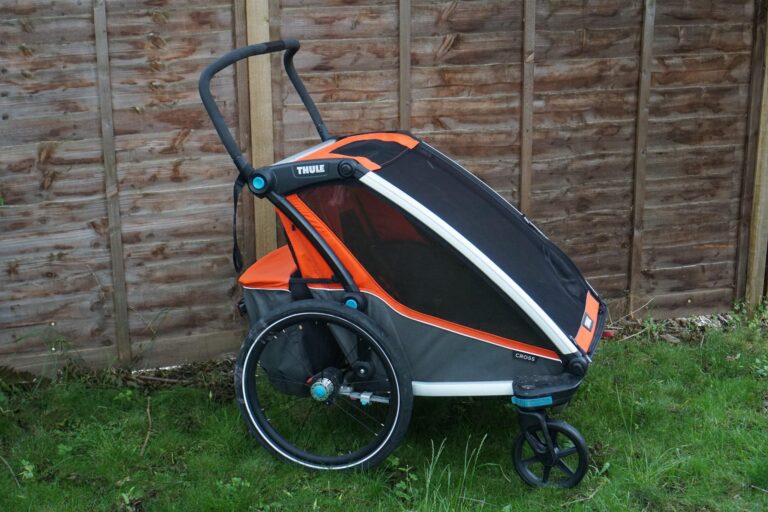Family Bike Touring in Brittany


Brittany is my favourite place to bike tour with children. I used to holiday in Brittany as a child, and I have a huge amount of nostalgia for this land of sunshine, beaches, chateaux, crepes and ice creams! The vast network of quiet country lanes make it a wonderful place to cycle with children, and there is also a great network of campsites, especially around the coast. If you want some totally traffic-free cycling, there is a network of ‘Voie-Vertes’ or green trails, mostly built on old railway lines.
We’ve toured four times in Brittany, twice with children, and I would love to go again! Here are some pointers if you’re considering a family cycling holiday in this beautiful corner of France.
- Getting to Brittany
- Hire bikes or take your own?
- The Voie-Vertes network
- Choosing your route
- Campsites in Brittany
- Breton culture and cuisine
Getting to Brittany
There are a number of ferry routes from the south coast of Britain, leaving from Portsmouth, Poole and Plymouth, and heading to Saint-Malo and Roscoff. Consult the Brittany Ferries and Condor Ferries websites for further details of timetables and prices.
Arriving at Saint-Malo
Saint-Malo is a beautiful old walled town in the eastern part of Brittany. I would highly recommend walking around the ramparts to admire the town. There is also a sandy beach just below the ramparts where you can stop for a paddle whilst awaiting your ferry home. The Portsmouth to Saint-Malo crossing runs overnight, which we have found very convenient for touring. You sleep on the boat, and arrive in time for fresh croissants in Saint-Malo in the morning, giving you a whole day to get started on your tour.
Saint-Malo is a good sized town, and it is worth giving some thought to how you will get out of town into the countryside, especially as you may still be getting used to your touring setting up and cycling on the right. One good option is to join the Voie Verte 3 heading south to Dinan. The voie verte begins in Dinard on the other side of the river Rance. The safest way to get across the river is via the foot passenger ferry from Saint-Malo to Dinard.
The crossing takes about 20 minutes, and Compagnie-Corsaire runs crossings throughout the day in the summer season. You can take bicycles for a small additional charge. You can also take tandems and bike trailers for a small additional charge – ‘Remorque’ is the French term for a trailer. The main downside of this route is that on the Dinard side there is a flight of steps down to the ferry! This is quite an experience with touring bikes, small children and two bike trailers. We found fellow passengers very helpful and friendly on the occasions that we have used this route. We generally have one adult stay with the children whilst the other adult takes several trips moving the baggage and bikes.






If you are planning an alternative route out of Saint-Malo, I would recommend printing a street map and highlighting your planned route so that you can get out of town safely and quickly. The Eurovelo 4 is a good option both to the south and to the west. There are signposts along the route, but it can be easy to miss one, and a street map should help keep you on track.
I would really not recommend crossing the Rance via the barrage, which is a very busy road. If you wish to avoid the ferry, the best thing to do is to head south on the EuroVelo 4 route and cross the Rance via Pont Saint-Hubert. Most of this route is quiet and cycle-friendly, but sections of the D117 can be quite fast-moving, and I prefer to avoid it with a bike trailer.
Arriving at Roscoff
Roscoff is a small port in the western part of Brittany. The Isle de Batz just off shore is a fun place to explore if you have some free time here. Roscoff is a great starting point for touring Finistere. The ferry crossing from Plymouth is shorter than to Saint-Malo, so it doesn’t work so well for an overnight crossing with small children (the ferry leaves long after bedtime). I would usually opt for the daytime crossing instead on this route.
The roads in this part of Brittany are generally quieter than the east anyway, and Roscoff is a small town, so it should not be difficult to find a safe cycle route out of the port. Camping Le Trogolot is convenient if you are arriving on a late afternoon or evening ferry and wish to stay nearby.
I would say that Roscoff is a more relaxing starting point for a family bike tour, particularly if this is your first experience. The town is smaller and the roads are quieter, making it easier if you need to stop to navigate, or to make adjustments to equipment. However, most ferries to Roscoff leave from Plymouth, which may be a less convenient starting point, depending on where you live in the UK.
Should you hire bikes or take your own bikes with you?
It depends on how much you like your own bikes, and where you want to tour!


If you already have bikes suitable for touring, the most budget-friendly option is to leave your car at the UK port (or get there by public transport), and take your bikes directly onto the ferry, and then tour straight from Saint-Malo or Roscoff in Brittany. Your bicycles will be roped up to a railing in the hold of the ship for the crossing, and you can ride straight off the boat on the other side. If you are taking small children or unusual bicycles (tandems, trailers) you may need to make a telephone booking rather than using the ferry company’s website.
If you are looking for long-stay parking in Portsmouth, we have used both the NCP Crasswell Street Car Park and the parking at Ferry Lodge Guest House. The Ferry Lodge is much more convenient for reaching the ferry terminal safely by bicycle.
If you are hoping to tour further afield, you may want to consider taking your car onto the ferry so that you can drive on to your starting point on the other side and unload your bicycles there. This will likely be significantly more expensive than booking just the bicycles onto the ferry. It does however open up your options of where to tour, for example the south coast of Brittany.
For those who are just trying out touring and would like someone else to supply the equipment, Breton Bikes supply touring bicycles and all the equipment (tents, sleeping bags, etc) along with maps, suggested routes and a repairs service! They are based in Gouarec in central Brittany. We haven’t used their full service but we have stayed at their campsite and found them to be welcoming and helpful people who really know their stuff when it comes to bicycles. The campsite was also well set up for small children.
The Voie-Vertes network
Brittany has a network of off-road cycle tracks called the ‘Voie-Vertes’ or green ways. Many of these are old railway lines, which means that they are straight and have very gentle gradients, so they can be fantastic for cycling with children, especially those on their own bicycles.
I have a love-hate relationship with the voie-vertes. They are very relaxing because they are so safe, and the navigation is very easy. However, the surface of the voie-vertes leaves much to be desired, especially in wet weather. They are surfaced in a sort of fine grit which is quite slow to travel on. In wet weather we have found them that it sticks to bike chains and can do some damage if you don’t clean it off carefully at the end of the day.
My preference is to use the voie-vertes for short sections to avoid busy roads or through a hilly area. Most of the time, the country lanes and back roads in Brittany are very quiet and safe, and the tarmac surface is much easier to cycle on! The Eurovelo Routes such as the EV4 use a mixture of off-road cycling and quiet roads, and these are also well signposted (for the most part!), so they can be a very good option if you want to find a quiet route but are happy to do some on-road cycling.


Choosing your route
If you are planning to use campsites then you do not need to decide your exact itinerary in advance. Indeed, one of the joys of cycle-touring is the freedom to change your route as you go along! I do still find it helpful to do quite a bit of advance preparation, especially with children. I find that the holiday is more relaxing if I have lots of information about potential campsites and safe cycling routes at my fingertips when I need it, and this gives us freedom to be more spontaneous.
Maps
This post contains affiliate links. As an Amazon Associate I earn from qualifying purchases.


Firstly, I get hold of the maps for the area we want to tour in. For Brittany I use IGN’s ‘Top 100’ range which are at a 1:100,000 scale. I find this convenient for touring, it shows almost all of the minor tracks, but still covers a large area on each map.
The IGN Top 100 maps for Brittany are:
Mileage
Next I estimate our daily mileage on the trip. This will vary hugely from person to person. We are still at the stage of getting slower each time as we add more children! For our family, about 20-30 miles a day is a comfortable amount of cycling, whilst allowing plenty of time for beach and playground trips, and time to unpack at the campsite each afternoon.
Research routes and campsites
Having an idea of our mileage helps me to plan how far we are likely to get, and what routes are feasible. I will then grab some highlighters and mark up on the map all the campsites in that area and any voie-vertes or Eurovelo routes.


There tend to be more campsites around the coast, and it can be tempting to hug the coast in order to enjoy the beaches! However, we have found that in general the roads are busier and hillier at the coast. It can sometimes work better to spend the day cycling inland, arriving at the coast in the afternoon to take advantage of a greater choice of campsites, and of course, the beach.
Suggested routes for a Family Bike Tour in Brittany
Here are some possible routes for a week-long cycle tour from one of the ferry ports:
Roscoff to St Brieuc: From Roscoff, travel east along the coast via Morlaix and Lannion. There are some beautiful and quiet beaches along this stretch, including the one at Saint Efflam. Continue east to the pretty old town of Treguier, and then on to Paimpol. You can camp overlooking the sea at Point d’Arcouest (Camping Panorama du Rohou), and if you like, visit the Isle de Brehat for a rest day. Follow the coast road down to St Brieuc via the beach town of Binic. Then wend your way back to Roscoff throught the pretty Breton interior, or retrace your route around the coast, perhaps taking in some different towns such as Pontrieux.


Finistere: From Roscoff, travel east to Morlaix, and take the Eurovelo 1 route (Voie Verte 7) south towards Carhaix-Plouger. The path is an old railway track and is a good way to traverse the hilly countryside hereabouts. You may want to divert off at Huelgoat for an overnight stop, and to enjoy the crazy giant boulder formations. Most children will love climbing on them! From Carhaix-Plouger, those wanting a longer route can continue to meet the south coast at the walled town of Concarneau. Alternatively, for an easier route head west to Locronan and on to the Crozon peninsula. You can take a ferry from Le Fret to Brest, and head back north towards Roscoff.


Saint Malo to St Brieuc: Take the ferry across the Rance to Dinan, and follow the Eurovelo 4 route to the west, taking in some of the pretty seaside resorts such as Saint-Jacut-de-la-mer, or Cap Frehel. Continue on to Yffiniac at the bay of St Brieuc, and turn south into the countryside, perhaps visiting the Chateau at Quintin before joining Voie Verte 6 and heading east towards Dinan.
Campsites in Brittany
There are lots of campsites in Brittany, particularly around the coast. We have found there to be a big range of pricing and level of amenities.
If you are looking for simple, budget-friendly campsites in France, try searching for ‘camping municipal’. These are the public campsites in most towns or communes, and they tend to be quite small and quiet with only basic amenities, but the pricing is excellent! They can also be in some really lovely locations, for example the camping municipal at Cap Frehel.
I usually try to choose a range of campsites through our tour, with some budget campsites, and others with a swimming pool or playground. I also try to make sure to include a couple of campsites with washing machines and tumble driers so that I can wash our clothes. Our children get really messy on tour, and it inevitably rains if I’ve washed clothes without access to a tumble drier! It is no fun ending up with a load of damp laundry in a tent in the rain.
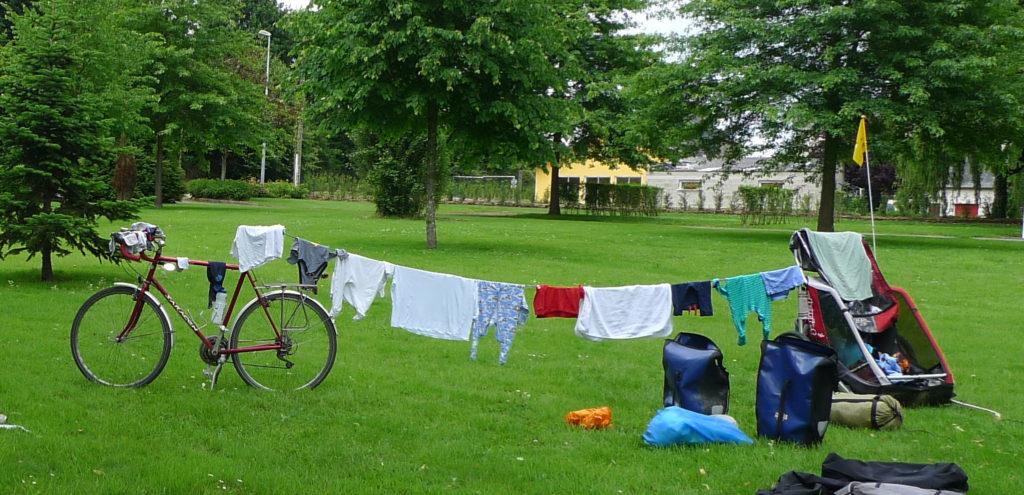

Breton culture and cuisine
Brittany has its own distinct identity, and did not become part of France until 1532. It shares some common heritage with other Celtic nations such as Cornwall and Wales. There are many beautiful chateaux to visit, some from medieval times. The countryside is pastoral, and quite hilly in parts of the interior, whilst around the coast are many pretty old fishing villages and beach resorts.
Breton cuisine is shaped by the landscape and history. You can sample some excellent seafood, especially mussels and crab. A particular Breton delight is the Galette, or savoury pancake, made of buckwheat flour, with your choice of filling, and washed down with a bowl of local cider.
Lots of Breton towns have weekly markets, which can be a great way to pick up some fresh local produce for lunch or supper.
Do you have a favourite destination for bike touring with children? Let us know in the comments section below!

